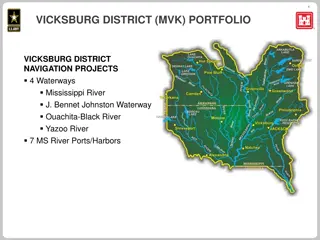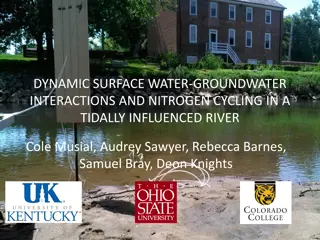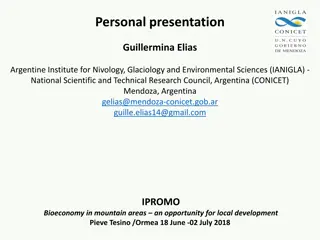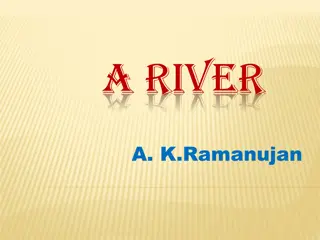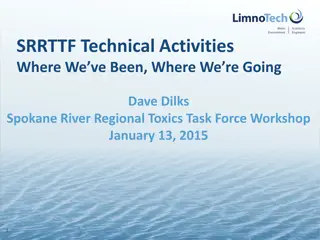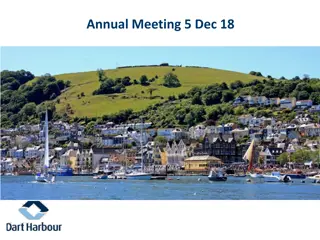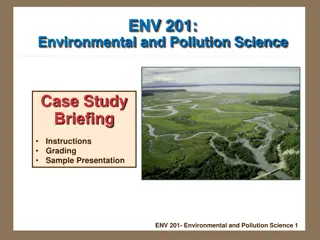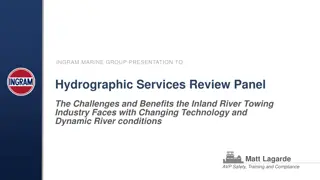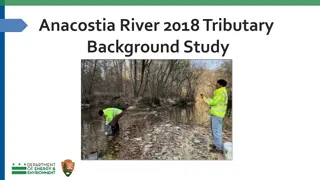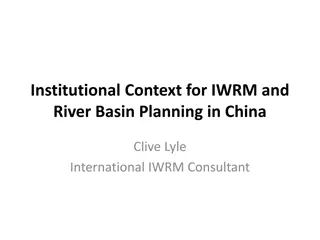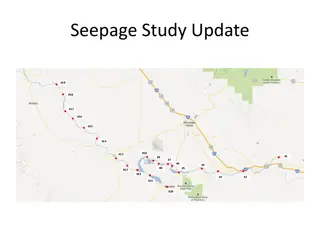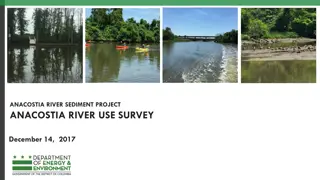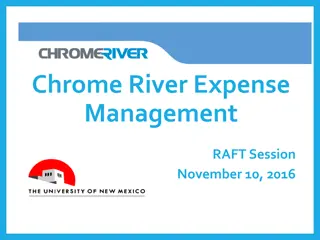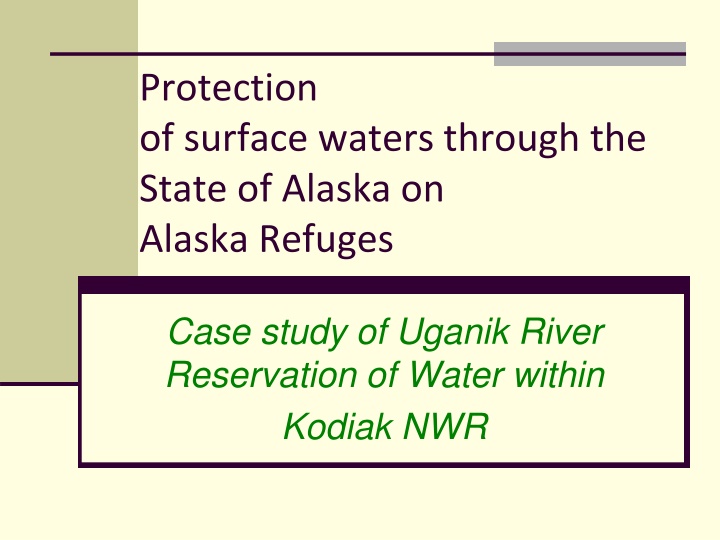
Protection of Surface Waters on Alaska Refuges: Case Study and Legal Mandates
Explore the measures taken to protect surface waters within Kodiak NWR in Alaska, including statutory mandates and water rights affecting the conservation efforts. Learn about the agency mission statements, conflicts, and similarities between U.S. Fish and Wildlife Service and Alaska Department of Natural Resources in water conservation efforts.
Download Presentation

Please find below an Image/Link to download the presentation.
The content on the website is provided AS IS for your information and personal use only. It may not be sold, licensed, or shared on other websites without obtaining consent from the author. If you encounter any issues during the download, it is possible that the publisher has removed the file from their server.
You are allowed to download the files provided on this website for personal or commercial use, subject to the condition that they are used lawfully. All files are the property of their respective owners.
The content on the website is provided AS IS for your information and personal use only. It may not be sold, licensed, or shared on other websites without obtaining consent from the author.
E N D
Presentation Transcript
Protection of surface waters through the State of Alaska on Alaska Refuges Case study of Uganik River Reservation of Water within Kodiak NWR
Statutory Mandates affecting Water Rights on Refuges Alaska National Interest Lands Conservation Act (ANILCA) (1980) Primary purpose of each refuge in Alaska Conserve habitats in natural diversity Ensure water quality and necessary water quantity National Wildlife Refuge System Improvement Act (NWRSIA) (1997) Maintain biological integrity/diversity/health Maintain adequate water quantity - quality Acquire water rights under State law
Other Water & Law Factors on Alaska Refuges Prior appropriation state w/ abundant water in unique hydrological and ecological systems Progressive state water law Expressed but unquantified FRWR in Alaska refuges Sparse baseline hydrologic data Limited ecological / biological data for aquatic habitat Economic factors oil/gas development, placer mining, water export, fisheries/wildlife, recreation, navigation, etc. Whole, intact, mostly pristine waters and watersheds, with water rights uncertainty
Agency Mission Statements: Conflicts & Similarities The U.S. Fish and Wildlife Service s (FWS) mission is working with others to conserve, protect, and enhance fish, wildlife, plants, and their habitats for the continuing benefit of the American people. The Alaska Department of Natural Resources (DNR) mission is to develop, conserve and maximize the use of Alaska s natural resources consistent with the public interest.
Mission Statements: Conflicts & Similarities cont FWS Conserve DNR Conserve and maximize Develop the use of natural resource (lands and waters) for public interest Protect and enhance fish, wildlife, plants, and their habitats for the benefit of the American people
Mission Statements: Conflicts & Similarities cont A Reservation of Water is the best route to gain protection and provide conservation .it is an opportunity. The FWS aims to meet its legal obligations to protect the natural diversity of populations and habitats under ANILCA by working through the state. It is the appropriate first step in ensuring water quality and quantity for refuges.
Agencys Water Right Policy FWS Obtain sufficient water and water rights Secure water rights under State law Assert and protect Federal interests in water, as necessary DNR Assure state interests within water for the public Neutral in determination of a reservation decision
Reservation of Water Purposes AS 46.15.145 (a)(1) Protect fish and wildlife Habitat, propagation, and migration Recreation Swimming, fishing, hunting, natural values, etc. Navigation/Transportation Sufficient quantity for boats, floatplanes, etc. Water quality Sanitary and water quality reasons
Agencys Water Right Process FWS: Conserve fish and wildlife populations and habitats in their natural diversity (ANILCA) Ensure water quality and necessary water quantity within the refuge (ANILCA) Maintain the natural flow regime (natural hydrograph: magnitude, frequency, duration, time and rate of change) Protect flows for important life stages and channel form and function DNR Reserved to the people for common use and is subject to appropriation and beneficial use Adjudication process assures: water is allocated in a reasonable and consistent manner based in part by public interest criteria Determination of the validity and amounts of a water right. Including conflicting claims among competing applications.
Why the Uganik River? First adjudication between DNR and FWS Data rich area (27 years of flow data) Strong fisheries component Low/No conflict issues that may arise in other FWS applications Straightforward An excellent start point
Uganik River History & Importance Provides migratory, spawning, and rearing habitat for sockeye, pink, chum, Coho and chinook salmon, steelhead, and Dolly Varden The Uganik River drainage basin is considered a major rainbow trout area The lower river is high use, key habitat for brown bear The East Arm of Uganik Bay, into which the Uganik River flows, provides prime wintering habitat for puddle ducks and maintains a high concentration of waterfowl. Subsistence hunting and trapping for residents of Port Lions and Ouzinkie
Uganik River Reservation Process Review the annual hydrograph Include the biologic aspect of the system in the form of fish life stage events Consider periods of changing flow, duration of those events, and magnitude of those events Define reservation time periods Define volume of flow associated with each time period
Uganik River Reservation Timeline Applied for on 9/27/2001 Adjudication process began January 31, 2012 Email and in face correspondence between DNR and USFWS March 20, 2012 June 12, 2014. Public/Agency notice published August 1, 2014 Certificates signed September 19, 2014 Recorded certificates received January 14, 2015
Considerations in Flow Discussions USFWS Fisheries/biological purpose Critical habitat needs Timing of flow events Overwintering Channel form and function River continuum paradigm DNR Fisheries/biological purpose Critical habitat needs Timing of flow events Competing uses (prior/future) Unappropriated Flows Laws Public Resource
Uganik Reservation Discussion Mean Time Discharge (cfs) USFWS Requested Flow (cfs) ADNR 1/2014 (cfs) ADNR 4/3/2014 (cfs) Time Period % % USFWS (cfs) % % USFWS (cfs) % FWS alt 5/20/14 % Exceed Exceed Exceed Exceed Exceed Exceed January* 232 250 18-20% 150 45% 230* 25% 150 45% 200 32% 200 32% February* 167 250 18% 130 45% 180* 25% 130 45% 150 34% 170 27% March* 150 250 10% 125 45% 150* 25% 125 45% 140 35% 147 28% April 1-14 172 140 50% 119 70% 140 50% 140 50% 140 50% 140 50% April 15-30 274 245 50% 175 70% 245 50% 245 50% 245 50% 245 50% May 1-14 623 589 50% 355 70-75% 590 50% 590 50% 590 50% 590 50% May 15-31 1049 958 50% 730 70-75% 960 50% 960 50% 960 50% 960 50% June 1770 1460 64% 1280 75% 1460 60-65% 1460 60-65% 1460 60-65% 1460 60-65% July 1460 1160 62-63% 990 75% 1160 60-65% 1160 60-65% 1160 60-65% 1160 60-65% August 896 690 55-56% 559 70% 690 55-60% 690 55-60% 690 55-60% 690 55-60% September 832 600 50% 416 70% 600 45-50% 600 45-50% 600 45-50% 600 45-50% October 675 400 56% 318 70% 400 55-60% 400 55-60% 400 55-60% 400 55-60% November 503 275 54-55% 198 70% 338 45% 338 45% 338 45% 338 45% December 258 250 35-36% 120 70% 200 45% 200 45% 200 45% 200 45% *Consents but acknowledges flows are insufficient to protect fish and wildlife habitat, migration, and propagation
Certificated Flows Remaining Flows for Appropriation (cfs) 32 Remaining Flows for Appropriation (gpd) 20,680,704 Mean Time Period Discharge (cfs) Granted Reservation Flows (cfs) Original Flow Requests (cfs) Reservation Flows (gpd) TIME PERIOD January* 232 250 200 129,254,400 February* 167 250 150 96,940,800 17 10,986,624 March* April April 1-14 150 226 172 250 170 140 90,478,080 10 6,462,720 140 90,478,080 32 20,680,704 April 15-30 May May 1-14 274 859 623 245 158,336,640 29 18,741,888 720 590 381,300,480 33 21,326,976 May 15-31 1049 960 620,421,120 89 57,518,208 June 1770 1460 1460 943,557,120 310 200,344,320 July 1460 1160 1160 749,675,520 300 193,881,600 August 896 690 690 445,927,680 206 133,132,032 September 832 600 600 387,763,200 232 149,935,104 October 675 400 400 258,508,800 275 177,724,800 November 503 275 338 218,439,936 165 106,634,880 December 258 250 200 129,254,400 58 37,483,776 *Consents but acknowledges flows are insufficient to protect fish and wildlife habitat, migration, and propagation
DNR Criteria in Decision A certificate of reservation can only be issued if the four criteria are met: 1. Prior appropriators rights aren t affected 2. Need exists 3. Unappropriated waters exist 4. Public interest (AS 46.15.080 (b))
Changed Perspectives FWS An understanding for DNRs mission Better understanding of the state adjudication process Willingness to compromise within the limits of our mission goals DNR Better understanding of FWS mission Willing to assist in the application process and applying for a reservation of water 11 AAC 93.142(c)
Changed Perspectives/Results FWS Good working relationship with DNR Completion of Uganik adjudication Cooperative scheduling of future adjudications DNR Working with the applicant Defendable decision document (legally/purpose based) Certificate of Protection The Uganik River was fully within refuge lands with minimal chance of any development occurring, which gave DNR the opportunity to view this river slightly different than other rivers.
Adjudication Results Goals met? Were there struggles between the two agencies? YES Response delays Unclear request/responses Additional projects/other work Did the agencies come to an agreeable conclusion without elevation? YES Were there lessons learned for the next FWS file adjudicated? YES Both agencies!
Lessons Learned Initiate a kick off meeting to discuss each parties concerns/desires and outline action plan-clear action plan will avoid future misunderstandings Each party should set goals for the process by clarifying what issues in the application are the most important Create a timeline associated with the action plan that is agreed to by both organizations-the timeline will provide an schedule and a projected date for finalization Create a forum for open and transparent communication While there is an understanding that certain documents need additional internal review, a quicker adjudication occurs when requested actions are carried out in a speedy manner One single point of contact familiar with the application
The End! Questions? Cathy Flanagan Hydrologist/Water Rights Specialist US FWS Kim Sager Water Reservation Specialist/ Adjudicator AK DNR kimberly.sager@alaska.gov 907-269-2033 cathleen_flanagan@fws.gov 907-786-3903


